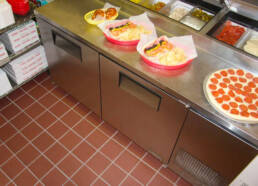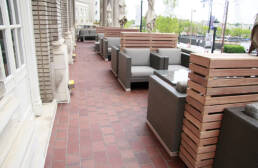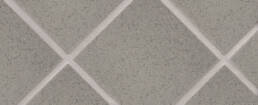What is Unglazed Quarry Tile?
 I started my career in the tile industry when the ‘new millennium’ was still a decade away. If you had told me back then that one day I would be writing a blog titled ‘What is Quarry Tile?’ I would have scoffed. And then asked ‘what is internet?‘ Yet, here we are.
I started my career in the tile industry when the ‘new millennium’ was still a decade away. If you had told me back then that one day I would be writing a blog titled ‘What is Quarry Tile?’ I would have scoffed. And then asked ‘what is internet?‘ Yet, here we are.
The company I worked for then made all four kinds of tile – ceramic mosaics, glazed wall tile, pressed floor tile, and quarry tile.
Mosaics were little and went in locker rooms and pools. Wall tiles were 4 1/4″ squares that sometimes were blue or gold or green but usually were white. Pressed floor tiles got up to 12″ square if you were really wild and had the same repeating pattern screen printed on every one. And then there was quarry tile. Durable, eternal, and available in a rainbow of earth tones, quarry tile was well known and understood.
You can still find all of these tiles of course, but they’ve been joined by countless sizes, shapes, and decorating techniques until the distinctions have become blurred. Many designers and installers today are not aware of what sets quarry tile apart from other types of tile. I will be blogging about what it is and how to install it. Today we will look at what quarry tile is:
The textbook definition – Our old friend, the Tile Council of North America Handbook defines it this way: Quarry tiles are ceramic tiles for floor and wall applications made by the extrusion process from natural clay or shale. The ANSI standard specifications for ceramic tiles offer some additional guidance pointing out that quarry tiles are allowed more size and warpage variation than porcelain tiles and can have up to 5% absorption.
The practical definition – The textbook definitions are designed to allow for a large variety of similar products to be defined as quarry tile. From a practical standpoint, the things you will want to know are:
Extruded – Quarry tile is extruded. That means the clay is mixed together and pushed with an auger through a die opening and then cut with a cutter to the proper size. This matters from a practical perspective because extruded tiles form a durable ‘die skin’ on the surface that helps with chemical and stain resistance.
For more information on how quarry tile is made, see our Youtube video.
Vitreous – Although ANSI allows up to 5% absorption, for most applications you will want quarry tile that is considered vitreous which means it has less than 3% absorption. This helps the tile withstand freeze-thaw cycles outside and staining inside.
Unglazed – Although there are glazed quarry tiles out there, the vast majority of quarry tile is unglazed. That means there is no glaze to chip off and if the tile does wear, the color under the surface is the same as the color on top.
Chemical and stain resistant – Unlike some porcelains and most wall tiles, quarry tile is not easily etched or stained by common chemicals. You will typically find it used in commercial applications like commercial kitchens and breweries.
Slip Resistant – Along with chemical resistance, quarry tile has a high coefficient of friction which improves traction. For the most rigorous slip resistant flooring applications, versions are available with tread patterns and abrasive grains.
There are other considerations that are important for quarry tile such as having the right trim shapes available for sanitary requirements and barrier free (ADA) regulations. For now you have the basics, quarry tile is an unglazed, extruded tile made out of clay that should have less than 3% absorption so it can go in demanding environments where chemical and slip resistance are important considerations. In our next post, we will take a look at some of the installation requirements for quarry tiles.
Don't use this type of grout for Commercial Kitchens

Single component grouts that can be scooped directly from the bucket and applied to tiles have become increasingly popular over the last 10 years. These ready to use grouts are great for many applications, but should never be used in commercial kitchens even if the advertisement says they offer ‘all of the benefits‘ of epoxy grout. They aren’t epoxy grouts and the differences are most obvious in a commercial kitchen setting. All of them exclude environments where harsh chemicals are used in their Technical Data Sheet.
Quarry tile is the most popular floor covering for commercial kitchens because it is very resistant to anything you can throw at it. The grout you pair with the quarry tile needs to be equally resistant to harsh cleaners, grease, and other conditions found in this environment. The enzymatic cleaners typically used for commercial kitchens are designed to digest fat and grease particles with enzymes. While the best practice is to then rinse these cleaners from the floor, often that is not done. This creates oleic acid that can damage cement grout, standard epoxy grout, and single component grouts.
For commercial kitchens, Metropolitan recommends the use of 100% solids epoxy grouts designed specifically for this type of application. Generally these are advertised as industrial epoxy grouts. Common grouts in this category include Kerapoxy IEG from MAPEI, Spectralock 2000 IG from Laticrete, and CEG-IG from Custom Building Products. There are others available as well. These grouts take practice to install as they are often stiffer and more challenging to clean than standard epoxy grouts. However, they are much easier to work with than the old technology, furan grouts. When in doubt, consult the installation products manufacturer to get their grout recommendation for your installation.


